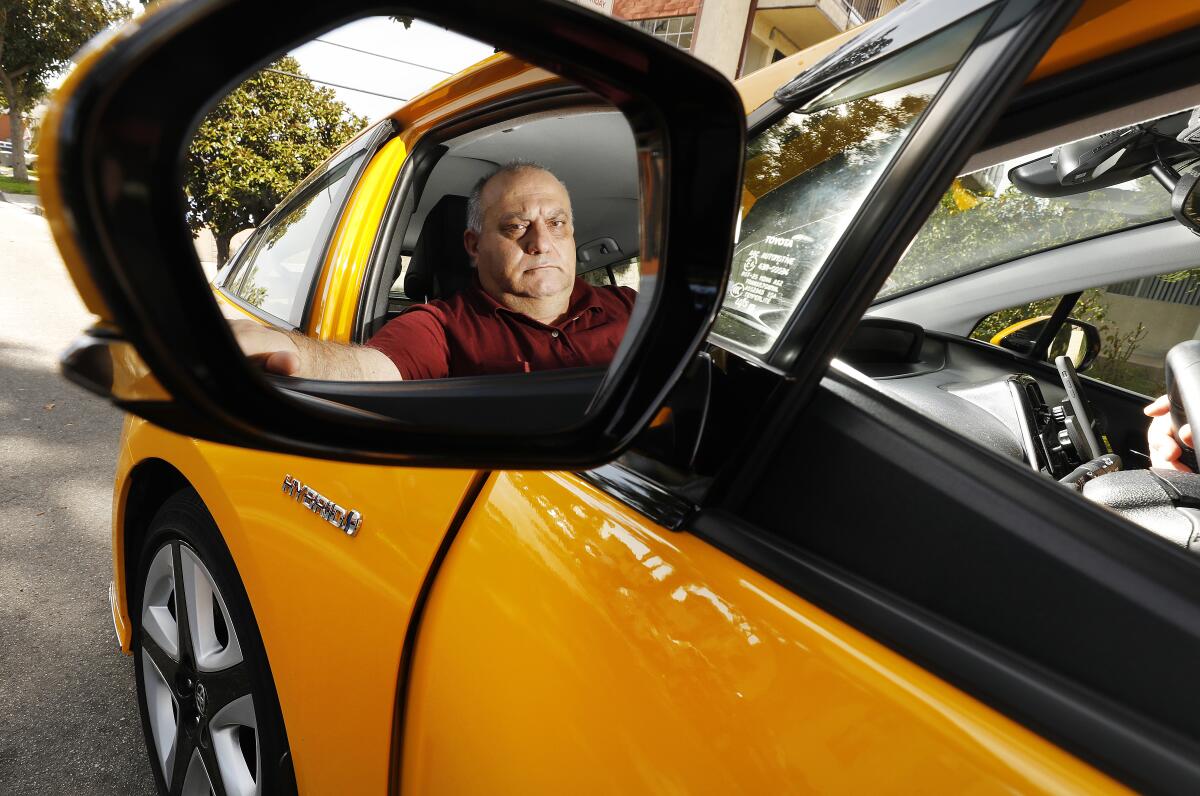Column: Cabbies hit by LAXit pickup squeeze are planning their own exit

- Share via
Varuzhan Shahazizyan drives a Prius that’s painted such a bright shade of yellow, you’d think it was a taxi.
Until a couple of weeks ago, it was.
Shahazizyan, a cabbie for nearly 20 years, got tired of hustling more and earning less as ride-hailing companies began to dominate the market. His dues to Yellow Cab were costing a steady $1,500 a month or so even as his weekly take-home dipped to about $500 a week.
And things got way worse, he said, when LAX switched last fall to a central pickup location for cabs and ride-hailing services alike, which put more of a squeeze on the dying taxi industry’s holdout drivers.
So Shahazizyan quit driving for Yellow Cab of Los Angeles, removed all the firm’s markings from his car, and made the switch to a company he used to think of as the enemy.
Now there’s a Lyft sticker in his car window.
“Yes,” he said, he used to hate Lyft and Uber.
“Yes,” he said, he used to hate their drivers too.
“But I have to make a living,” Shahazizyan said.
Not that it’s going so well. Shahazizyan has only been at it a short time with Lyft, but estimates he’s driving at least twice as many miles and working 12-hour days to match the $500 a week or so he was clearing as a cabbie.
And that about sums up the takeaway here.
For customers with apps, getting a ride somewhere has never been cheaper or more convenient.
For drivers, no matter who they work for, earning a decent living ain’t so easy.
“We have lost 12 to 15 drivers since October,” said Jano Baghdanian, general manager of L.A. City Cab.
Ever since the ride-hailing companies came along and set prices artificially low while benefiting from fewer regulations than taxi companies, cab companies have lost hundreds of drivers in L.A. On Thursday, taxi drivers marched in protest once again at LAX.
It used to be that cabs picked up airport passengers at baggage claim. But during a long-term construction project, the airport in late October initiated the LAXit system, in which passengers awaiting pickup by cabs or ride-hailing companies are shuttled to a nearby lot.
Baghdanian said cabs used to have their own stands at baggage claim, but now they’re sandwiched by their competition. Passengers get off the shuttles, see the Lyft and Uber pickup stations, and tap their apps. And those fares have run way lower than cab fares, thanks to price regulation on taxis and other factors.
The other disadvantage for cab drivers is that passengers willing to pay more for Lyft and Uber’s premium services can avoid that inconvenient shuttle ride altogether and get picked up at baggage claim, but cabbies don’t have such a service.
“Uber and Lyft are laughing all the way to the bank,” said William Rouse, general manager of Yellow Cab.
He and other cab company executives have been trying to get the airport to let taxi drivers return to the old system or some modified version, at least on a trial basis. But the arguments fall on deaf ears, said Rouse.
Becca Doten, a spokesperson for the airport, said the cab companies have been included in policy discussions since 2018 and the conversations continue. She added that the airport supports taxi reform proposals drafted by the Los Angeles Department of Transportation, with features including a single phone number or app for passengers to hail a cab from any company and the replacement of fare meters with set fares the way Lyft and Uber have.
You want to go to Anaheim, say, or Woodland Hills? Then here’s the up-front price.
But it has been difficult getting cab companies and drivers on board. The proposals “haven’t met with universal support,” said Eric Spiegelman, president of the L.A. Taxicab Commission. Different taxi companies and their drivers have different perspectives, he said, and there have been “voices pro and against” the reform proposals.
No doubt, the taxi industry doesn’t have a history of great marketing and has been painfully slow to modernize. But as long as it costs more to take a cab, and millions of amateur drivers are content to make close to minimum wage driving for Uber and Lyft, the future for taxi drivers is bleak.
But the final chapter hasn’t been written. Uber is now testing a system that allows drivers in some areas to increase their rates themselves, a move the ride company hopes could help it fight a new state law that reclassifies drivers as employees rather than independent contractors. Uber, Lyft, Doordash, Postmates and other companies are pushing a ballot initiative that would repeal the new law but pay drivers a minimum of $21 an hour with potential benefits.
Yellow Cab driver Caesar Bravo, for one, is not optimistic that things will get much better for taxi drivers. Ten years ago, he said, he was offered $100,000 for the seal that gives him an ownership stake in Yellow Cab. He turned it down, he said, and now wouldn’t be able to sell it for a nickel.
“Nobody wants to own a share of a business that is dying,” said Bravo, 61, who has driven for 40 years.
“When I broke in, it was a middle class job. But if you want to survive today, you have to be willing to drive more for lower pay, and you have to be willing to adapt.”
With his mini-van cab, he said, he’s able to make $1,000 a week transporting special students to and from a Van Nuys school under a contract. But beyond that, the most lucrative part of his business was airport pickups, which aren’t what they used to be.
Bravo and his wife raised three kids and bought a house when he made good money. Now, he said, they don’t go out to eat as much and they don’t take vacations.
Mekonen Alemayehu, who drives for L.A. City Cab, told me he had a retirement plan worked out. He owns two cabs, leases one to another driver, and the plan was to sell both when he was ready to call it quits. Now, the driver he’s leasing to is quitting, and neither cab has any value on the market.
Alemayehu thinks about quitting too, but doesn’t know what he’ll do for a living after 35 years as a driver.
Shahazizyan, at least, has a plan to make the most of his bright yellow Prius. He’s waiting on clearance to drive for Uber, as well as Lyft. Working 12 hours a day, seven days a week, he hopes to last until summer, when he plans to move to either Fresno or Las Vegas.
His two-bedroom, one-bath apartment in Glendale costs $1,625 a month, he said. He figures he can save a bundle on housing once he leaves Los Angeles, and then he’ll look for work as a truck driver.
The people behind Uber and Lyft have made millions, Shahazizyan said, and for passengers, “it’s good, it’s cheap.”
But for drivers, it’s a race to the bottom, and he’s looking for an exit.
More to Read
Sign up for Essential California
The most important California stories and recommendations in your inbox every morning.
You may occasionally receive promotional content from the Los Angeles Times.











